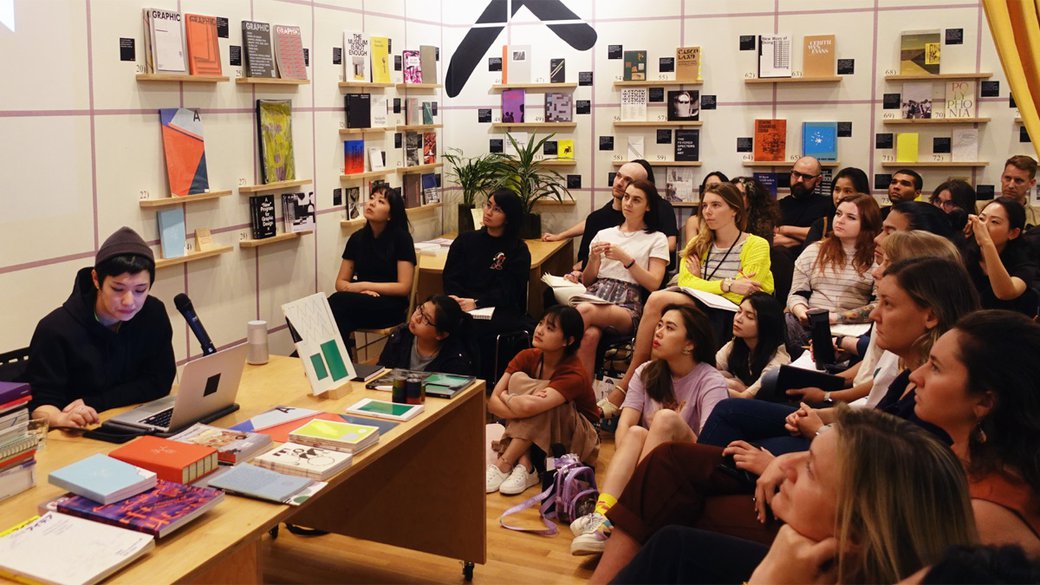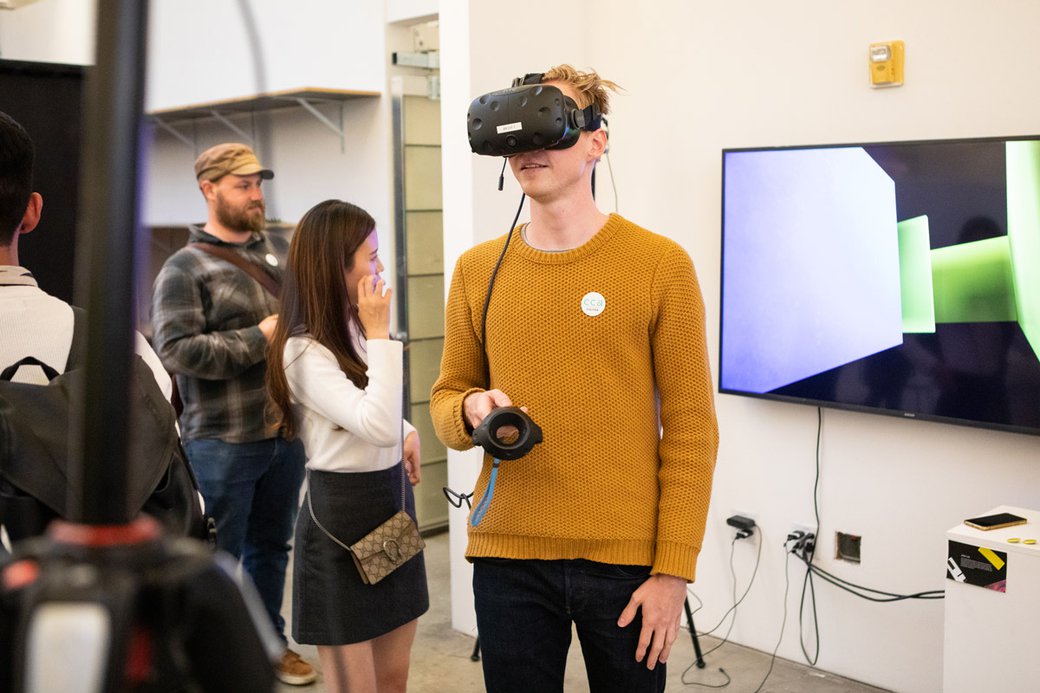
BFACommunication Design
Overview
Design the way ideas move

Designer and curator Na Kim speaks to a group at the Curatorial Research Bureau in San Francisco. Courtesy of the Curatorial Research Bureau.
A visual language for the future
Communication design shapes the way the world connects. How something looks, moves, or behaves is part of its message. As a Communication Design major, you’ll study how to make these choices with intention, using typography, image-making, and interaction to bring ideas to life—not just clearly, but powerfully. Communication design can move people, change minds, and deepen understanding in a complex world. Here, you’ll learn how.
A global hub for communication innovation
The Bay Area has long been a hub for reimagining how people communicate—from the rise of counterculture publishing in the ’60s to zines in the ’90s to today’s intersection of design and tech. CCA is shaped by this legacy of using boundary-pushing design to transform culture. You’ll study alongside practicing designers with deep ties to and gain access to real-world opportunities in a city that continues to define the future of communication design.
Studios & Shops
From posters to prototypes

Become fluent across formats, tools, and ideas
Communication Design students access a full range of creative tools—from risograph and letterpress to CNC routers, digital looms, and VR gear. In our state-of-the-art studios and spaces, you’ll try things out, get hands-on, and experiment across mediums. Want to design a brand campaign featuring a typeface you created? Create a custom digital experience? Launch a small-run independent publication? You can. Learning happens through making and tools are part of the process, helping you push your ideas further and bring your work to life in unexpected ways.
Faculty
Influential designers and artists
Helping sharpen your approach
You’ll learn from designers who are actively shaping the field. Our faculty have worked on everything from app interfaces to museum exhibitions, from editorial design to global brand campaigns. But in the classroom, their focus is on you. Faculty lead with curiosity and challenge you to do the same—encouraging critical thinking, experimentation, and bold creative choices. In critiques, they’ll help you see your work from new angles, ask better questions, and sharpen your ideas.

Jennifer Sonderby, Chair of Communication Design
Jennifer Sonderby approaches design as a form of cultural translation—developing visual systems that support how institutions and communities navigate shifts in identity and purpose. She led the San Francisco Museum of Modern Art's design studio through a comprehensive rebrand, developing the award-winning visual identity that launched with the museum's major expansion—reimagining how visitors experience one of the world's leading contemporary art institutions. Through her studio, Sonderby Design, she continues to lead initiatives for museums, nonprofits, and ecommerce organizations —bridging strategy and expression through long-term collaborations and systems-level thinking.
She leads the CCA’s Communication Design program with a practice-based approach—grounded in experience and shaped by curiosity. As both an alumna of the CCA MFA Design program and an active practitioner, she builds curriculum that fosters independent thinking, thoughtful making, and the agility to respond to a rapidly evolving design landscape
Faculty stories

CCA welcomes new Communication Design chair Jennifer Sonderby
The college is thrilled to welcome Jennifer Sonderby as the new chair of Communication Design, where she builds on the program’s legacy and expands into digital, product, and experience design.

Forbes covers Rachel Berger's exhibition, "Shooter Box"
Graphic Design Chair Rachel Berger spoke with Forbes about Shooter Box, an exhibition of designed objects protesting the U.S. military’s use of Microsoft Xbox controllers as battle equipment.
Curriculum
Grow as you go
Begin with tools, end with impact
The Communication Design curriculum is designed to grow with you. Throughout the program, you’ll learn to think in systems, lead with ideas, and use making as a way of discovering meaning. View sample courses.

Build a strong design vocabulary
In your first year, you’ll be introduced to core tools, visual systems, and studio culture. The second year deepens that foundation with a set of intentionally connected studios in communication design, typography, and interaction.
Explore focused practice areas
You’ll enter a series of Advanced Studios your third year. These flexible, topical courses let you explore focused areas of practice like branding, motion design, AR/VR, data visualization, and editorial publishing. Studio themes evolve in response to the field, giving you the chance to stay current while developing your own direction. Taught by practicing designers, these studios help you build both depth and versatility as you define your path.
Make your professional debut
Your fourth year centers on a self-directed Senior Thesis developed over two semesters. This capstone experience brings together everything you’ve learned in a public-facing body of work that reflects your values, voice, and process as a designer.
BFA Communication Design
Foundational Curriculum
- Drawing Studio
- 3.0 units
- 2D Studio
- 3.0 units
- 3D Studio
- 3.0 units
- 4D Studio
- 3.0 units
- Introduction to the Arts
- 3.0 units
- Introduction to the Modern Arts
- 3.0 units
- Writing 1
- 3.0 units
- Writing 2
- 3.0 units
- Foundations in Critical Studies
- 3.0 units
Communication Design Major Requirements
- Communication Design Tools
- 3.0 units
- Communication Design 1–2
- 6.0 units
- Typography 1–2
- 6.0 units
- Interactive 1-2
- 6.0 units
- Sophomore Review
- 0.0 units
- Advanced Studio
- 12.0 units
- Media History 1
- 3.0 units
- Media History 2
- 3.0 units
- Communication Design Electives
- 3.0 units
- Senior Thesis 1
- 3.0 units
- Senior Thesis 2
- 3.0 units
- Studio Electives
- 9.0 units
Collegewide Curriculum
- Critical Ethnic Studies Studio
- 3.0 units
- Upper Division Interdisciplinary Studio
- 3.0 units
- Critical Ethnic Studies Seminar (2000 level)
- 3.0 units
- Literary and Performing Arts Studies (2000 level)
- 3.0 units
- Philosophy and Critical Theory (2000 level)
- 3.0 units
- Social Science/History (2000 level)
- 3.0 units
- Science/Math (2000 level)
- 3.0 units
- History of Art and Visual Culture (2000 level)
- 3.0 units
- Humanities and Sciences Electives (2000/3000 level)
- 6.0 units
- Humanities and Sciences Electives (3000 level)
- 6.0 units
Total 120.0 units
Careers
Launch your design life

Work on what you care about most
Communication Design graduates leave CCA with a portfolio and a distinctive point of view. In a world shaped by constant communication, the ability to design messages that are clear, intentional, and impactful is a powerful asset. Our alumni bring these skills to studios, startups, nonprofits, and tech companies—or launch their own creative practices. Wherever you go next, you’ll be ready to shape the future through design.
What careers do communication design students pursue?
Our alumni design visual identities, build apps and interfaces, animate stories, publish independent zines, and create experiences that move across screens, print, and public space. They work as product designers at startups, brand designers at creative studios, type designers, art directors, strategists, and content creators. Some design for civic impact or climate action. Others bring design thinking into education, research, or new technology. With a flexible, future-ready foundation, you’ll be prepared to shape your career in a wide range of ways—and lead the future of communication.
Success stories

Iconic modern design at a San Francisco modernist landmark
CCA alum/professor Eric Heiman's studio Volume Inc. designed the Eames furniture exhibition at the Transamerica Pyramid. They created the show in 5 weeks, using colored glass panels and eye-level displays to highlight design details.

CCA alum known as the go-to designer for top Bay Area restaurants
Robert van Horne (BFA Graphic Design 2007) has become a leading graphic designer for California wine labels and Bay Area restaurants. His logos, signs, menus, etc. have quietly shaped the visual vocabulary of today’s food and drink world.

Director Lindsay Daniels Brings Her Drive for Deeper Connections to the FANCY Roster
A design background influences her goal of telling broader stories in film and forging a deeper emotional resonance with viewers
News & Events
Let’s redefine design

California College of the Arts announces two new members joining its Board of Trustees
The college is pleased to announce the appointment of two new trustees, David Saxe and Bonnie Hewson, effective July 25, 2025.

Five reasons to consider a STEM-designated undergraduate program at an art school
From state-of-the-art tools and industry partnerships to opportunities to make a real-world impact and design the future, learn why a STEM-designated undergraduate program at an art school may be right for you.

Keen as folk: Quality Time
What do MFA design students do after graduation? Alumni from collaborative design studio Quality Time share the foundation of their work and the importance of community-building.
How to Apply
Design work that makes a difference
CCA’s BFA Communication Design program is for students who believe that visual culture is more than just decoration — it’s how we connect and drive change. Whether you're into type, motion, interaction, publishing — or still figuring it out — you’ll find the tools, mentors, and studio energy to create work that resonates across

